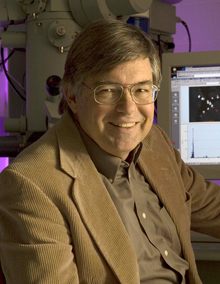Stardust NExT must love comets. On Valentine’s Day, the spacecraft got up close and personal with its second one.

It’s been seven years since the original Stardust danced with the comet Wild 2, out beyond the orbit of Mars, capturing a thimbleful of comet dust that was later delivered to Earth for testing via a sample-return capsule. On February 14, the probe again made history in a 125-mile embrace with comet Tempel 1, previously explored by NASA’s Deep Impact mission in 2005. It is the first time a comet has been visited by two spacecraft, providing an opportunity to compare observations over time.
Donald Brownlee, UW professor of astronomy, had a ringside seat for the 2006 Wild 2 flyby as Stardust’s principal investigator. He is a co-investigator for Stardust NExT.
Brownlee says that knowledge about comets has shifted significantly in just the last five years, thanks to the Wild 2 samples that Stardust sent back to Earth. He explains that scientists expected the non-icy parts of the comet to be made up of particles that flowed into the solar system from out in the cosmos. Instead, it turned out that nearly everything bigger than a micron (one-millionth of a meter) in diameter was formed in the inner solar system, and at very high temperatures. The material somehow was carried out beyond the planets where it picked up frigid ices and was incorporated into comets.
“When the solar system was forming, it was actually turning itself inside out,” Brownlee explains. “I think we’re seeing a component that was uniformly distributed when the solar system was forming.”
Stardust NExT was unable to collect samples during its recent Valentine’s Day encounter with Tempel 1, since the spacecraft’s collector returned to Earth in 2006. But it has captured images that will provide valuable information to scientists.“This mission is 100 percent successful,” asserted Joseph Veverka of Cornell University, principal investigator for the Stardust NExT mission, soon after the flyby. “We saw a lot of new things that we didn’t expect, and we’ll be working hard to figure out what Tempel 1 is trying to tell us.” Already, photos of the crater that was formed by the Deep Impact mission’s collision with the comet are providing hints that the comet’s nucleus may be fragile and weak.
Brownlee says that getting two high-profile science missions from the Stardust spacecraft took a lot of careful planning, but there also was a measure of luck.”It took a lot of hard work,” he says, “but a lot of things had to go right.”

After 12 years of being guided by mission controllers at NASA’s Jet Propulsion Laboratory, the office-desk-sized Stardust spacecraft will continue to orbit the sun on its own. It will still have its scientific instruments and its camera, a spare from the Voyager program. It also still carries two microchips bearing the names, in microscopic type, of more than 1 million Earthlings who signed up before the launch.
Brownlee recalls the bittersweet moment at the end of the first Stardust mission, when the spacecraft was put into hibernation until needed again, and the board in the control room flashed “LOS” – loss of signal. He knows that even now, after its NExT mission, the spacecraft will remain out there, making long loops around the sun for perhaps a million years, until it crashes into Earth or, more likely, is ejected by gravity from the solar system.
“When it’s chucked from the solar system by Jupiter, the spacecraft and its ‘crew’ of signatures will keep going for billions of years,” says Brownlee. “The chip will probably be readable after the Earth is gone.”